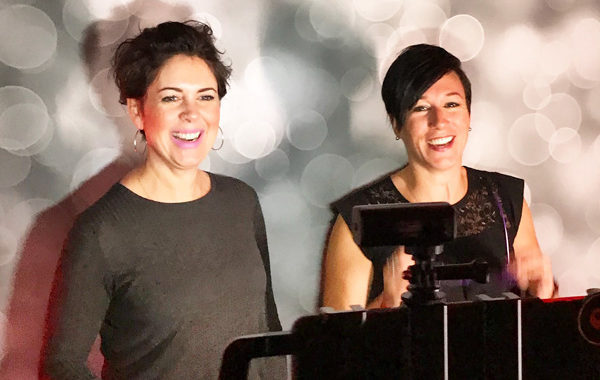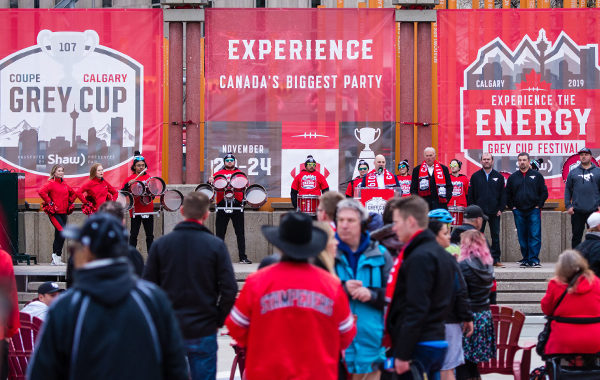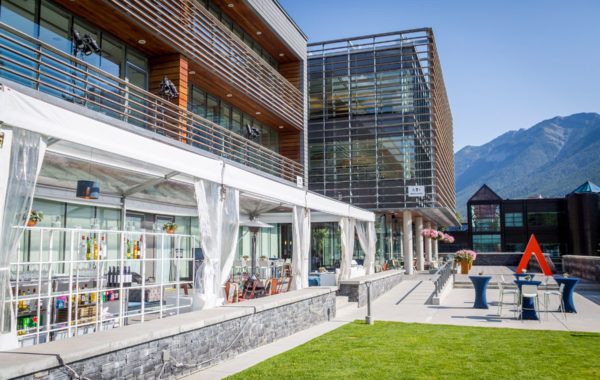Need to flip one 50,000 square-foot hall four times in 21 days, while working around several other large events that are restricting both your access and your storage? Discovering during load-in that your caterer has forgotten half of the tables you booked? No problem! Enter Jennifer Thacker, Project Manager, problem solver, and our go-to for the most challenging projects.
“I love a logistics challenge,” Jen says, with all sincerity. “Anything that’s hard to pull off is exciting to me, and I really see problems as a chance to be creative and accomplish something great.” Around here, Jen’s ability to look back on even the most challenging and complex projects as “not that bad” is the stuff of legends, and her relentless positivity and otherworldly resourcefulness are exactly what you want and need on your team. So, let’s take a step-by-step look at Jen’s approach to tackling a challenging event head-on, dealing with problems that inevitably pop up, and staying cool, calm, and collected through it all.

The best offence will always be a good defense.
Jen’s first line of defense is always solid and thorough planning.
“I start scoping logistics problems as we’re talking through design,” she says. Jen and the rest of the project management team carefully map out every section of an event during the concept stage, working through the best ways to plan for and execute everything from load-in to Health and Safety management, and trying to anticipate possible problems. For example, for a recent event that spanned 5 floors of the National Music Centre, PLUS 2 floors and the rooftop of the King Eddy across the street, it was imperative to keep the product needed for the 8 different spaces incredibly organized. Packing all of the product together would not only affect the efficiency of unloading, but could easily result in items being lost across multiple floors or even across the street. To make sure this didn’t happen, Jen divided each space into zones with corresponding detailed packing lists, and each zone was packed into separate trucks. This meant product could be unloaded and elevatored up to each space quickly and easily, and ensured that everything arrived on the correct floor and in the correct zone, with no confusion.
This is just one example of Jen’s creative solutions that are built into each logistics plan, all of which go a long way toward stopping those facepalm moments before they happen.
Even a logistics superhero can’t plan for everything.
The cold, hard truth is that problems are going to come up no matter how experienced and thorough you are. What matters is how you deal with it when the pressure’s on, and everyone’s looking at you. Jen’s personal approach?
“Always know that there is a solution to the problem,” she says, without hesitation. “There’s nothing we can’t fix; we solve problems every day.” Here’s a closer look at how she walks through problem solving.

1. First of all, make sure there really is a problem.
Tensions and emotions can run high during the busy lead-up to a big event, and that’s increases exponentially once you’re actually on site and setting up. In many cases, there are so many people and moving parts that it’s easy for wires to get crossed, communication to break down, and problems to get blown out of proportion.
In Jen’s case, she is the main hub of information for the project, so often someone might be reacting to a problem that she’s in fact already dealt with. If someone tells you that the chairs you had booked are actually across the city at another event, Jen recommends asking a few questions before you start freaking out. Maybe someone already foresaw that problem and more chairs were actually purchased weeks ago. Before you start moving heaven and earth, take a deep breath and do some digging.

2. Be a team player.
In Jen’s view, ‘not my problem’ is simply not a thing. If a problem comes up, instead of looking for someone else to blame (or to handle it), think about how you can help.
“It doesn’t matter who dropped the ball or what happened, we will always find a solution,” she says. “That’s what makes us different and that’s the value we bring to our clients. We will always make something work.”

3. Brainstorming is about letting go and getting creative.
So there really is a problem, and you’re a team player. Now what?
Jen’s goal is always first and foremost to find the solution that has the least effect on the event – what that does not mean is stubbornly hanging on to the original idea or plan. Creative problem solving is all about being able to let go and think differently; if you can’t do that, you’ll end up circling around and around the problem, and getting nowhere. Next, think about what you have access to, and who you have access to.
“Always start with what you have on site that can fix the problem,” Jen says. “Sometimes your truck will be pre-loaded for another event that you can ‘borrow’ from – look in the back of truck!” Maybe the venue has product you can use, or one of your vendors can step in.
If there’s nothing on site that can help you, or your problem is not one that involves product, ask yourself who can help? This is where your relationships with your vendors and partners become so important. Scroll through your contacts list for that perfect person with exactly the product, equipment, skills, or connections you need to solve this problem.

4. If you’re stuck, phone a friend.
“When the pressure’s on and you’re in the thick of things,” Jen says, “the best thing to do is call someone who is not under that same pressure, and can help you talk it through.”
The same principle applies here as when you dial up your best friend, your mom, your therapist… whomever you like to talk things out with when something is driving you crazy. Talking through the problem with someone who is not immersed in the project or attached to the original plan can be exactly what you need to shake yourself loose and get that lightning bolt of inspiration.
When it comes to on-site emergencies, Jen’s phone-a-friend usually goes to Orlando, our Chief Operating Officer. When problems come up a little earlier in the process, our weekly operations meetings are a great chance to brainstorm with the whole team. Whomever you call, talk it through and let their fresh perspective change yours.
5. Present solutions, not problems.
Remember that relentless positivity we mentioned? Jen applies that to her commitment to never bring a problem to her client. Instead, she brings a solution – or options for a solution – to a problem that came up and was handled.
“The more calm you can stay, the better,” Jen says. “The worst thing is for a client to feel that you’re panicking. Own your solution, and have confidence in your team.”
Make sure everyone who needs to know about the change is in the loop, then simply execute and move on.

Events are not a solo sport, and in the end, that’s the real key to problem-solving.
Events are such a collaborative effort, and nothing builds camaraderie and a sense of accomplishment like pulling off a really tough project as a team, working side-by-side with our partners, vendors, and clients. The same philosophy applies to taking on a big problem and beating it together.
“I can’t stress enough how important your partnerships are when it comes to problem solving,” Jenn concludes. “When you have strong relationships, you have people to fall back on; people who will step in with ideas and solutions at the 11th hour when the stakes are high. You can’t do this alone.”
And of course, remember that this is a two-way street – you need to be willing to step up when your partners reach out to you for help.
The final takeaway.
“After every event,” Jens says, “I assess what was successful, what problems came up, and what I learned from it – and then I just move on.”
If you have your own thoughts on logistics and problem-solving to add to the conversation, or want to see Jen and the rest of the team pull this stuff off in person (we promise you, it’s a sight to behold), give us call or drop us a note. We’d love to solve problems with you!




